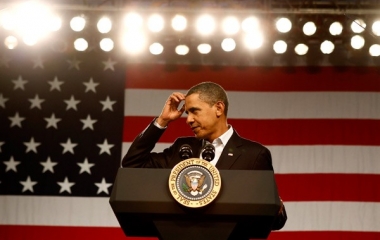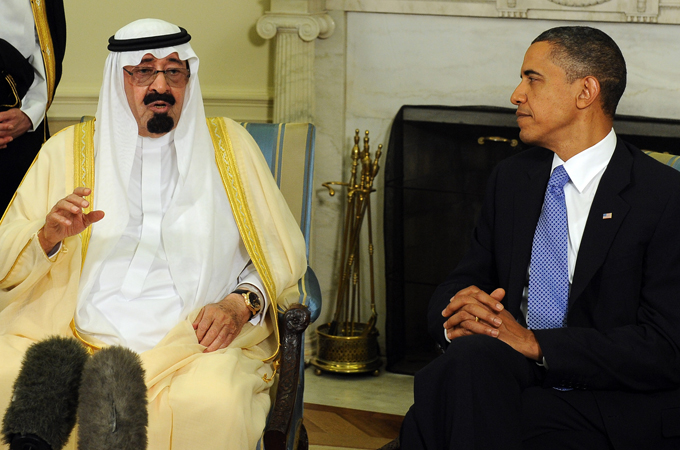Will President Obama go down in history for having set a new course on foreign policy, or for having shown unexpected continuity with his predecessor?
As one of his first acts after taking office, President Barack Obama signed an executive order to close the detention facility at Guantanamo Bay within one year. “This is me,” the President said at the signing ceremony, “following through on not just a commitment I made during the campaign, but I think an understanding that dates back to our founding fathers, that we are willing to observe core standards of conduct, not just when it’s easy, but also when it’s hard.”[1] Eighteen months later the administration admitted that this particular task was, however, too hard. “The president can’t just wave a magic wand to say that Gitmo will be closed,” a senior official anonymously informed The New York Times. Faced with insuperable political obstacles, Obama has adopted a fallback position. Elevating good intentions over actual results, the new policy makes a show of trying to shut down the facility. Another anonymous official further explained to The New York Times that “closing Guantanamo is good, but fighting to close Guantanamo is O.K. Admitting you failed would be the worst.”[2]
This policy is virtually identical to the one that President Bush followed for three years prior to his departure from office. “I’d like to end Guantanamo,” Bush told an audience in Vienna in June 2006.[3] “I’d like it to be over with.” He followed this statement by outlining the specific steps that he was taking to turn his intention into reality. “The president wants to close the facility,” Bush administration officials said to whoever would listen. “We’re trying, but it’s hard.”
Jack Goldsmith, writing in The New Republic in May 2009, observed that the Guantanamo policy shift is not an isolated case.[4] On warrantless wiretapping, targeted killings, and military commissions-on these, as well as many other issues, Obama’s policies have slid into a groove carved out by George W. Bush. Obama’s failure to deliver radical change has caused consternation on the left. Last spring fear grew among civil rights activists that the president would renege on the administration’s commitment to try terrorists in federal court. In an effort to stop the backsliding, the ACLU took out an arresting ad in The New York Times. It depicted a series of photos in which Obama’s portrait gradually morphed into that of George Bush. “What will it be Mr. President,” the caption read. “Change or more of the Same?”[5]
II. Rival Theologies
The ACLU raises a good historical question: Will President Obama go down in history for having set a new course on foreign policy, or for having shown unexpected continuity with his predecessor?
Whatever the similarities between Bush and Obama on specific policies, the two are separated by an intellectual gulf that is quasi-theological in nature. Obama brought to the White House what might be called a new “strategic belief system”-that is, fundamental assumptions, which cannot be easily tested and disproved, about the nature of the international order and the American role in it.
To understand the difference between the Bush and Obama worldviews, a good place to begin is by examining their respective definitions of the strategic threat. In the aftermath of 9/11, Bush was faced with a choice: to declare a narrow war against al-Qaeda, with Afghanistan as the central theater; or to adopt a more expansive definition of the enemy. Bush went wide. He defined the strategic threat as “Nexus”-as, that is, the convergence of state sponsors of terrorism, terrorist groups, and weapons of mass destruction. That definition placed the United States in conflict with al Qaeda, certainly, but also with Saddam’s Iraq, Iran, Syria, Hezbollah, and Hamas. Bush did not regard all of these adversaries as direct enemies of the United States; nevertheless the War on Terror drew a bright line, and then lumped together all these actors on the other side of it.
Obama considered this lumping process crude. The idea of a War on Terror, he reasoned, was a classic example of strategic overreach. The effort to ostracize terror sponsors backfired: it forced a number of potentially helpful states, such as Iran and Syria, solidly into the enemy camp. These regimes, though unsavory and opposed to Washington on some issues (particularly those relating to Israel) nonetheless share with the United States a deep hostility to al-Qaeda. A less Manichean approach would, therefore, allow Washington to exploit this overlap in interests. Consequently, Obama has drawn a much narrower definition of the threat. He has declared war only on al Qaeda and related movements.
Obama’s perspective is based on the consensus of the foreign policy establishment. In December 2006 this consensus was codified in an authoritative document, “The Iraq Study Group Report,” authored by James Baker and Lee Hamilton. The report called for five new major policies: withdrawal from Iraq; renewed focus on Afghanistan; diplomatic engagement of Iran and Syria, and a revitalized Arab-Israeli Peace Process.[6] Although the Baker-Hamilton Report is all but forgotten today, it is of great historical interest, because it captured the bipartisan critique of the Bush foreign policy which served, in effect, as the operational playbook of the Obama administration when it first took office.
The wide and narrow definitions of the strategic threat are reflections of two irreconcilable sets of beliefs about the nature of the international system. The wide definition assumes that the vital interests of the United States are threatened today by the convergence of a series of factors: hostile rogue states, nuclear proliferation, terrorist networks with global reach, indifferent allies, unhelpful international institutions, and competition from Russia and China, among others. Taken individually, each of these problems is manageable; together, however, they form a potent danger. Particularly in the Middle East, the threat is so significant that it requires resolute attention and a readiness, when necessary, to use American military power unilaterally.
By contrast, the narrow definition sees an international arena that is far more hospitable to the United States. If Washington would refrain from counterproductive behavior-exhibiting condescension toward international norms and institutions, unilateralism, brandishing its hard power-the current system is adequate for neutralizing strategic threats, which are nowhere near as great as they were during the Cold War.
This theological dispute describes a fundamental and irreconcilable disagreement between Bush and Obama. With that thought in mind, it is possible to reformulate the ACLU’s question, which, in the light of the previous discussion, translates into the following: When Obama leaves office, will he depart with the narrow definition of the strategic threat intact; or will he be forced, Guantanamo-style, to adopt significant elements of Bush’s definition?
III. Going Wide
In the end, I believe Obama will go wide. His narrow definition is simply inadequate for explaining to the American people the actions that the United States will be forced to take in order to address the threats currently arrayed against it in the Middle East. To understand why this is so, it is helpful to review the experience of Jimmy Carter.
Like Obama, Carter took office believing that his predecessors had exaggerated the strategic threat of the day, and had prosecuted a senseless, self-destructive war. The threat, of course, was the Soviet Union; the war, Vietnam. In seeking a hard-power solution to the spread of communism, the United States had grown estranged from its better angels and, in doing so, undermined American security. On May 27, 1977, Carter delivered a famous address at Notre Dame University, where he announced a major course correction and a return to core values:
Democracy’s great recent successes-in India, Portugal, Spain, Greece-show that our confidence in this system is not misplaced. Being confident of our own future, we are now free of that inordinate fear of communism which once led us to embrace any dictator who joined us in that fear. I’m glad that that’s being changed.
For too many years, we’ve been willing to adopt the flawed and erroneous principles and tactics of our adversaries, sometimes abandoning our own values for theirs. We’ve fought fire with fire, never thinking that fire is better quenched with water. This approach failed, with Vietnam the best example of its intellectual and moral poverty. But through failure we have now found our way back to our own principles and values, and we have regained our lost confidence.[7]
The international system, Carter assumed, was relatively benign-provided, that is, that the United States would stick to the high road and refrain from stirring up opposition to itself.
This definition of the strategic threat proved inadequate, however. A series of provocations from Moscow made it harder and harder for the President to defend his claim that fears of communism were “inordinate.” Then, in December 1979, the tipping point came with the Soviet invasion of Afghanistan. Carter’s perception of danger was magnified by the fact that the Red Army had rolled across the Afghan border less than a year after the Iranian revolution. The confluence of these two events stoked fears in Washington that Moscow might seek to exploit American vulnerabilities in the Persian Gulf.
As a consequence, Carter was forced to repudiate, albeit tacitly, his Notre Dame speech. He responded to the Soviet invasion with a bold statement of American primacy: the Carter Doctrine. At his state of the Union address in January 1980, he dwelt at length on the strategic importance of the Persian Gulf and on the Soviet threat to it. He then capped his remarks with this memorable statement: “Let our position be absolutely clear: An attempt by any outside force to gain control of the Persian Gulf region will be regarded as an assault on the vital interests of the United States of America, and such an assault will be repelled by any means necessary, including military force.”[8] The Persian Gulf, the president told the world, was an American lake. The Carter Doctrine spoke in terms of protecting the Gulf from an “outside force.” This rhetoric was politically-expedient shorthand, not an exhaustive, academic description of the danger as Washington actually understood it. From the beginning, Carter saw the intentions and capabilities of the Soviet Union as but one element of a complex threat-one which included dangers from inside the region, Iran first and foremost. The following chronology of events in 1979 and 1980 provides a sense of the context:
February 1979: The Ayatollah Khomeini returned to Tehran.
November: Juhayman al-Utaybi occupied the Grand Mosque in Mecca.
December: The Soviets invaded Afghanistan.
January 1980: The Carter Doctrine was proclaimed.
September: Iraq invaded Iran.
Carter faced, simultaneously, a potentially adventurous Soviet Union, an expansionist and revolutionary Iran, domestic unrest in Saudi Arabia, and major conflicts between states in the region. Taken together, these factors posed a threat to the most vital American interest: the free flow of oil at reasonable prices.

In seeking to safeguard this interest, Carter quickly learned a lesson in the indispensability of American military power. The Persian Gulf is a stool with four legs: Saudi Arabia; Iraq; Iran, and the smaller sheikhdoms. During most of the Cold War, one leg, Iraq, was pro-Soviet. So long as the remaining three legs were pro-American, a regional balance that safeguarded the vital interests of the United States ensued. When, however, Iran turned hostile to the United States in 1979, American interests came to rest on only two legs, Saudi Arabia and the sheikhdoms. In order to restore stability, Carter had no choice but to prop up the teetering structure with American military power. He immediately developed the Rapid Reaction Force, which President Reagan developed further into United States Central Command.
Ironically, Carter came to Washington with the intention of cooperating with Moscow and abjuring a reliance on hard power. He left proclaiming American hegemony, and developing the military tools needed to protect it. Try as he might, Obama will find this legacy impossible to escape-not because the Carter Doctrine itself is a straightjacket but, rather, because the Gulf conundrum has yet to be solved. Only American hard power-wielded responsibly but unilaterally-can provide the balance that will safeguard American interests, which include today, in addition to ensuring the free flow of oil, protecting the lives of Americans soldiers serving in the region, and preserving the hard-won gains in Iraq.
Like Carter, Obama faces a multidimensional threat in Middle East. The war in Iraq was designed, among other goals, to fashion an indigenous third leg to the Gulf stool. That project is well advanced but still far from complete. The new order in the country is very fragile. It is threatened today by revolutionary Iran, which, with the help of its partners, Syria, Hezbollah, and Hamas, is also mounting a multi-pronged challenge to the United States elsewhere in the region. The Iranian alliance shares at least one important interest with al Qaeda: a desire to oust the Americans from the Gulf, if not the entire Middle East. Whatever the defects of Bush’s concept of a “War on Terror,” it did have the benefit of ostracizing all of the various actors who are currently working to undermine the United States and its allies in the Middle East. It provided big-arrow guidance for the wide range of activities that the United States will inevitably conduct in the region.
Obama’s concept of a war on al Qaeda will prove inadequate to the task. A definition of the strategic threat that fails, above all, to address the challenge that Iran poses to American primacy will not stand the test of time.

IV. The Grand Illusion
Neutralizing the Iranian alliance should be the overarching strategic goal of the United States in the Middle East. The Obama administration, however, has been slow to define Iran as the central problem. A major cause for this reluctance is, ironically, another Carter legacy. Obama is following in the Carter tradition of viewing Arab-Israeli peacemaking as a primary strategic task. This view, not surprisingly, was also enshrined in the Baker-Hamilton report. “The United States,” the report stated, “cannot achieve its goals in the Middle East unless it deals directly with the Arab-Israeli conflict and regional instability. There must be a renewed and sustained commitment by the United States to a comprehensive Arab-Israeli peace on all fronts….”[9]
This perspective, which flourished under Carter, fits hand in glove with the narrow definition of the strategic threat. Carter’s views coalesced in reaction to the policies of Nixon and Kissinger, who regarded the Arab-Israeli conflict, not as an independent arena of international relations, but as a subset of the Cold War. They regarded Israeli power as an asset for establishing American primacy. Israel provided Washington with an instrument for placing key strategic players, especially Egypt, with a clear choice: war and economic stagnation under the Soviet umbrella; or peace and Western economic investment under American aegis. Only the United States-not the Soviet Union-could deliver peace with Israel to the Arab states, Nixon and Kissinger reasoned. Therefore, the American-Israeli alliance enhanced American power and prestige. Carter saw this approach as an extension of the zero-sum mentality in the Cold War that he sought to extirpate from American strategic thinking. In addition, it stirred up enmity. Israeli power was, in Carter’s view, as much a liability as an asset, because it transformed Arabs who otherwise had no quarrel with America into its antagonists. Promoting peace, in his mind, was therefore synonymous with restraining Israel, whose aggressive policies were part of the larger problem that he addressed in his Notre Dame speech-namely, snarling America.
Obama sees himself as providing an identical corrective to the perceived excesses of his predecessor. Bush, he believes, moved too close to the Israelis. By supporting them unquestionably, he alienated Muslims throughout the Middle East. In addition, Bush’s War on Terror blurred the vital distinction between the enemy of the United States, al Qaeda, and Israel’s enemies-Iran, Syria, Hezbollah, and Hamas. An invigorated peace process, Obama reasons, will reduce hostilities across the board and render the region more hospitable to the United States.
Whatever one thinks about this approach, one point is undeniable: it made more strategic sense in Carter’s day. This is so because a seismic shift took place in the international politics of the Middle East on Carter’s watch. Prior to the Camp David Accords, the primary regional ally of the Soviet Union had been revolutionary Egypt. In 1978, Egypt changed sides in the Cold War. The United States gained a strategic ally, and, as a result, the Eastern Mediterranean was significantly pacified. Within a year, however, the United States lost a major ally, Iran, in the Gulf. Iran eventually went on to take up the mantel of revolutionary Egypt as the leader of anti-American forces in the region. When Egypt and Iran traded places, the center of gravity in the region shifted to the Gulf. However, Arab-Israeli peacemaking is tool for calming the Eastern Mediterranean. It has limited or no value with respect to the problems in the Gulf.
In Carter’s day, the decision of Egypt to make peace with Israel represented a major strategic benefit to the United States. The Soviet Union had lost its premier client in the Middle East. The blow to Moscow was immense. Today, however, the potential for a similar strategic breakthrough is nonexistent. Obama’s efforts are focused on brokering an agreement between Prime Minister Benjamin Netanyahu and President Mahmoud Abbas. Unlike Egypt under Anwar Sadat, however, the Palestinian authority under Abbas already occupies a position within the American security system. If, against all odds, the talks somehow produce an Israeli-Palestinian agreement, American interests will be advanced only slightly. A settlement would take years to implement. Iran and its friends-Syria, Hamas and Hezbollah-will work violently to scuttle it every step of the way. In short, the basic strategic picture that we already see today will remain unchanged.
Meanwhile, the problem of Iranian power in the Gulf will fester. Consider the following thought experiment: If the Obama administration were to solve the Palestinian-Israeli conflict, would the problem of building a stable order in the Gulf diminish significantly? Would a signing ceremony on the White House lawn between Netanyahu and Abbas lead to a single American soldier being removed from Iraq?
And yet the Begin-Sadat handshake continues to captivate Washington. The Arab-Israeli conflict carries a deceptively strong valence: it simply feels as if it stands at the heart of everything in the Middle East. Its connection to profound religious and ethnic affiliations, both at home and abroad, imbue it with dramatic qualities that have led leaders from both political parties, habitually, to overestimate its true strategic value. From Harry Truman down to our day, a phalanx of experts has always stood ready to argue that solving the conflict is the key to shoring up the American position in the region. The Egyptian-Israeli peace, brokered by Carter, had the effect of validating these feelings, which are profoundly misleading in today’s context.
Carter has left behind a contradictory legacy. His doctrine calls on Obama to safeguard American hegemony; the success of the Camp David Accords, however, creates the illusion that peacemaking is the means to do so.
V. An Uncertain Legacy
Over time, Obama is bound to recognize the illusion for what it is. When he came to power he announced two major initiatives in the region: outreach to Iran and Syria, and Israeli-Palestinian peacemaking. Neither effort has borne fruit; nor will they ever. Iran and Syria see themselves as rivals of the United States, not potential partners. They intermittently talk the language of cooperation to gain tactical advantage in an asymmetric contest, but their very nature will preclude Obama from achieving any advantage from his friendly outreach, just as the nature of the Soviet Union undermined Carter’s policy of accommodation. At the same time, the administration will also come to realize that its efforts at brokering an Israeli-Palestinian peace, though worthwhile tactically and morally, will never pay great strategic benefits. Consequently, events will push the president toward adopting a comprehensive strategy against Iran and its allies. Obama will come to see not just al Qaeda but also Iran, Syria, Hezbollah, and Hamas as entrenched on the opposite side of a bright line separating American regional allies and their adversaries. His definition of the strategic threat will go the way of Guantanamo, sliding asymptotically toward Bush’s policy.
Does this mean, then, that once the dust settles the Obama administration will be remembered, as the ACLU fears, for offering more of the same? It is too early to tell. The answer will depend on how quickly the administration pursues primacy where it truly counts: in the Gulf and in the contest with the Iranian alliance system. It took Carter nearly three years to go wide. His administration, therefore, is remembered neither for continuity nor change, but, instead, for waffling. Sooner or later, the enemies of the United States will force the president to reevaluate. Obama’s true choice, therefore, is between continuity and waffling.
Guest P ost by:
Michael Doran is a visiting professor at the Robert F. Wagner Graduate School for Public Service at New York University. Previously, he was an assistant professor of Near Eastern Studies at Princeton University and taught at the University of Central Florida. He was appointed to the National Security Council and Department of Defense under the George W. Bush administration. He received his Ph.D. in Near Eastern Studies from Princeton University. This essay is based on a lecture for a two-day history institute for teachers sponsored by FPRI’s Wachman Center in cooperation with the American Institute for History Education on U.S. Foreign Policy and the Modern Middle East.


